Skip to comments.
The Pascha miracle of Holy Fire appears at the tomb of Jesus Christ (pictures)
yahoo.com ^
| Sat Apr 10, 3:27 PM ET
Posted on 04/11/2004 1:46:16 AM PDT by Destro
The Pascha miracle of Holy Fire appears at the tomb of Jesus Christ (pictures)
 Christian worshipers surround what is traditionally believed to be the tomb of Jesus Christ, during the Holy Fire ceremony during Easter celebrations at the Church of the Holy Sepulchre in Jerusalem's Old City, Saturday, April 10, 2004. The ceremony is meant to assure the worshippers that Jesus has not forgotten them and is sending a message of hope through the fire. (AP Photo/Brennan Linsley)
Christian worshipers surround what is traditionally believed to be the tomb of Jesus Christ, during the Holy Fire ceremony during Easter celebrations at the Church of the Holy Sepulchre in Jerusalem's Old City, Saturday, April 10, 2004. The ceremony is meant to assure the worshippers that Jesus has not forgotten them and is sending a message of hope through the fire. (AP Photo/Brennan Linsley)
 Israeli police in blue uniforms push back pilgrims and Evzones, right, members of the Greek Presidential guard, who escorted Greek Orthodox Patriarch of Jerusalem Irineos I, unseen background right, as he exits the tomb, during scuffles in the Holy Fire ceremony at the Church of the Holy Sepulcher in east Jerusalem's Old City Saturday, April 10, 2004. Thousands of Christian Orthodox pilgrims wait outside the tomb, where Jesus Christ is traditionally believed to be buried, for hours until the Greek Orthodox Patriarch opens the doors carrying the holy flame which is then used to light all the other candles of the faithfull. (AP Photo/Lefteris Pitarakis)
Israeli police in blue uniforms push back pilgrims and Evzones, right, members of the Greek Presidential guard, who escorted Greek Orthodox Patriarch of Jerusalem Irineos I, unseen background right, as he exits the tomb, during scuffles in the Holy Fire ceremony at the Church of the Holy Sepulcher in east Jerusalem's Old City Saturday, April 10, 2004. Thousands of Christian Orthodox pilgrims wait outside the tomb, where Jesus Christ is traditionally believed to be buried, for hours until the Greek Orthodox Patriarch opens the doors carrying the holy flame which is then used to light all the other candles of the faithfull. (AP Photo/Lefteris Pitarakis)
 A Greek Orthodox monk, lights the candles of the tomb, where Jesus Christ is traditionally believed to be buried, with Holy Fire following the Holy Fire ceremony in the Church of the Holy Sepulcher at east Jerusalem's Old City Saturday, April 10, 2004. Thousands of Christian Orthodox pilgrims wait outside the tomb for hours until the Greek Orthodox Patriarch opens the doors carrying the holy flame which is then used to light all the other candles of the faithfull. (AP Photo/Lefteris Pitarakis)
A Greek Orthodox monk, lights the candles of the tomb, where Jesus Christ is traditionally believed to be buried, with Holy Fire following the Holy Fire ceremony in the Church of the Holy Sepulcher at east Jerusalem's Old City Saturday, April 10, 2004. Thousands of Christian Orthodox pilgrims wait outside the tomb for hours until the Greek Orthodox Patriarch opens the doors carrying the holy flame which is then used to light all the other candles of the faithfull. (AP Photo/Lefteris Pitarakis)
 A Russian Orthodox monk, lifts up candles with Holy Fire as crowds of orthodox Christian worshippers and clergymen light candles with Holy Fire from each other during a ceremony in the Church of the Holy Sepulcher in east Jerusalem's Old City Saturday, April 10, 2004. Thousands of Christian Orthodox pilgrims wait outside the tomb, where Jesus Christ is traditionally believed to be buried, for hours until the Greek Orthodox Patriarch opens the doors carrying the holy flame which is then used to light all the other candles of the faithfull. (AP Photo/Lefteris Pitarakis)
A Russian Orthodox monk, lifts up candles with Holy Fire as crowds of orthodox Christian worshippers and clergymen light candles with Holy Fire from each other during a ceremony in the Church of the Holy Sepulcher in east Jerusalem's Old City Saturday, April 10, 2004. Thousands of Christian Orthodox pilgrims wait outside the tomb, where Jesus Christ is traditionally believed to be buried, for hours until the Greek Orthodox Patriarch opens the doors carrying the holy flame which is then used to light all the other candles of the faithfull. (AP Photo/Lefteris Pitarakis)
 The lights of a candlelight procession leave trails as Christian worshippers surround what is traditionally believed to be the tomb of Jesus Christ, during the Holy Fire ceremony during Easter celebrations at the Church of the Holy Sepulchre in Jerusalem's Old City, Saturday, April 10, 2004. (AP Photo/Brennan Linsley)
The lights of a candlelight procession leave trails as Christian worshippers surround what is traditionally believed to be the tomb of Jesus Christ, during the Holy Fire ceremony during Easter celebrations at the Church of the Holy Sepulchre in Jerusalem's Old City, Saturday, April 10, 2004. (AP Photo/Brennan Linsley)
 Christian worshippers hold candles at the Holy Fire ceremony during Easter celebrations at the Church of the Holy Sepulchre in Jerusalem's Old City, Saturday, April 10, 2004. The ceremony is meant to assure the worshippers that Jesus has not forgotten them and is sending a message of hope through the fire. (AP Photo/Oded Balilty)
Christian worshippers hold candles at the Holy Fire ceremony during Easter celebrations at the Church of the Holy Sepulchre in Jerusalem's Old City, Saturday, April 10, 2004. The ceremony is meant to assure the worshippers that Jesus has not forgotten them and is sending a message of hope through the fire. (AP Photo/Oded Balilty)
 A Christian worshipper holds a candle at the Holy Fire ceremony during Easter celebrations at the Church of the Holy Sepulchre in Jerusalem's Old City, Saturday, April 10, 2004. The ceremony is meant to assure the worshippers that Jesus has not forgotten them and is sending a message of hope through the fire. (AP Photo/Oded Balilty)
A Christian worshipper holds a candle at the Holy Fire ceremony during Easter celebrations at the Church of the Holy Sepulchre in Jerusalem's Old City, Saturday, April 10, 2004. The ceremony is meant to assure the worshippers that Jesus has not forgotten them and is sending a message of hope through the fire. (AP Photo/Oded Balilty)
 Christian worshippers and clergymen light candles outside what is traditionally believed to be the tomb of Jesus Christ during the Holy Fire ceremony during Easter celebrations at the Church of the Holy Sepulchre in Jerusalem's Old City, Saturday, April 10, 2004. The ceremony is meant to assure the worshippers that Jesus has not forgotten them and is sending a message of hope through the fire. (AP Photo/Kevin Frayer)
Christian worshippers and clergymen light candles outside what is traditionally believed to be the tomb of Jesus Christ during the Holy Fire ceremony during Easter celebrations at the Church of the Holy Sepulchre in Jerusalem's Old City, Saturday, April 10, 2004. The ceremony is meant to assure the worshippers that Jesus has not forgotten them and is sending a message of hope through the fire. (AP Photo/Kevin Frayer)
 Orthodox Christians light candles inside the Church of the Holy Sepulchre during the 'Ceremony of the Holy Fire' in Jerusalem, April 10, 2004. Christian faithfuls believe the church is built on the site of Jesus' last resting place after his body was removed from the cross. The fire is first taken from inside the tomb and then rapidly spreads throughout the ancient church as faithful slight each other's candles. REUTERS/Reinhard Krause
Orthodox Christians light candles inside the Church of the Holy Sepulchre during the 'Ceremony of the Holy Fire' in Jerusalem, April 10, 2004. Christian faithfuls believe the church is built on the site of Jesus' last resting place after his body was removed from the cross. The fire is first taken from inside the tomb and then rapidly spreads throughout the ancient church as faithful slight each other's candles. REUTERS/Reinhard Krause
 A Christian worshipper holds candles at the Holy Fire ceremony during Easter celebrations at the Church of the Holy Sepulchre in Jerusalem's Old City, Saturday, April 10, 2004. The ceremony is meant to assure the worshippers that Jesus has not forgotten them and is sending a message of hope through the fire. (AP Photo/Oded Balilty)
A Christian worshipper holds candles at the Holy Fire ceremony during Easter celebrations at the Church of the Holy Sepulchre in Jerusalem's Old City, Saturday, April 10, 2004. The ceremony is meant to assure the worshippers that Jesus has not forgotten them and is sending a message of hope through the fire. (AP Photo/Oded Balilty)
 Christian worshippers hold candles as they walk around the Edicule, the place that is traditionally believed to be the tomb of Jesus Christ during the Holy Fire ceremony during Easter celebrations at the Church of the Holy Sepulchre in Jerusalem's Old City, Saturday, April 10, 2004. The ceremony is meant to assure the worshippers that Jesus has not forgotten them and is sending a message of hope through the fire. (AP Photo/Kevin Frayer)
Christian worshippers hold candles as they walk around the Edicule, the place that is traditionally believed to be the tomb of Jesus Christ during the Holy Fire ceremony during Easter celebrations at the Church of the Holy Sepulchre in Jerusalem's Old City, Saturday, April 10, 2004. The ceremony is meant to assure the worshippers that Jesus has not forgotten them and is sending a message of hope through the fire. (AP Photo/Kevin Frayer)
 Christian worshipers hold candles during the Holy Fire ceremony during Easter celebrations at the Church of the Holy Sepulchre in Jerusalem's Old City, Saturday, April 10, 2004. The ceremony is meant to assure the worshippers that Jesus has not forgotten them and is sending a message of hope through the fire. (AP Photo/Oded Balilty)
Christian worshipers hold candles during the Holy Fire ceremony during Easter celebrations at the Church of the Holy Sepulchre in Jerusalem's Old City, Saturday, April 10, 2004. The ceremony is meant to assure the worshippers that Jesus has not forgotten them and is sending a message of hope through the fire. (AP Photo/Oded Balilty)
 Christian worshipers hold candles during the Holy Fire ceremony during Easter celebrations at the Church of the Holy Sepulchre in Jerusalem's Old City, Saturday, April 10, 2004. The ceremony is meant to assure the worshippers that Jesus has not forgotten them and is sending a message of hope through the fire. (AP Photo/Oded Balilty)
Christian worshipers hold candles during the Holy Fire ceremony during Easter celebrations at the Church of the Holy Sepulchre in Jerusalem's Old City, Saturday, April 10, 2004. The ceremony is meant to assure the worshippers that Jesus has not forgotten them and is sending a message of hope through the fire. (AP Photo/Oded Balilty)
 Orthodox Christians light candles inside the Church of the Holy Sepulchre as they celebrate the 'Ceremony of the Holy Fire,' in Jerusalem April 10, 2004. Christian faithful believe the church is built on the site of Jesus' last resting place after his body was removed from the cross. The fire is first taken from inside the tomb and then rapidly spreads throughout the ancient church as the faithful light each other's candles. REUTERS/Goran Tomasevic
Orthodox Christians light candles inside the Church of the Holy Sepulchre as they celebrate the 'Ceremony of the Holy Fire,' in Jerusalem April 10, 2004. Christian faithful believe the church is built on the site of Jesus' last resting place after his body was removed from the cross. The fire is first taken from inside the tomb and then rapidly spreads throughout the ancient church as the faithful light each other's candles. REUTERS/Goran Tomasevic
 An Orthodox Christian man lights candles as he pray inside the Church of the Holy Sepulchre as the 'Ceremony of the Holy Fire' is celebrated, April 10, 2004. Christian faithful believe the church is built on the site of Jesus' last resting place after his body was removed from the cross. The fire is first taken from inside the tomb and then rapidly spreads throughout the ancient church as the faithful light each other's candles. REUTERS/Goran Tomasevic
An Orthodox Christian man lights candles as he pray inside the Church of the Holy Sepulchre as the 'Ceremony of the Holy Fire' is celebrated, April 10, 2004. Christian faithful believe the church is built on the site of Jesus' last resting place after his body was removed from the cross. The fire is first taken from inside the tomb and then rapidly spreads throughout the ancient church as the faithful light each other's candles. REUTERS/Goran Tomasevic
 Orthodox Christians light candles as they pray inside the Church of the Holy Sepulchre during the 'Ceremony of the Holy Fire,' in Jerusalem April 10, 2004. Christian faithful believe the church is built on the site of Jesus' last resting place after his body was removed from the cross. The fire is first taken from inside the tomb and then rapidly spreads throughout the ancient church as the faithful light each other's candles. REUTERS/Goran Tomasevic
Orthodox Christians light candles as they pray inside the Church of the Holy Sepulchre during the 'Ceremony of the Holy Fire,' in Jerusalem April 10, 2004. Christian faithful believe the church is built on the site of Jesus' last resting place after his body was removed from the cross. The fire is first taken from inside the tomb and then rapidly spreads throughout the ancient church as the faithful light each other's candles. REUTERS/Goran Tomasevic
 Orthodox Christians light candles inside the Church of the Holy Sepulchre as the they celebrate the 'Ceremony of the Holy Fire' in Jerusalem, April 10, 2004. Christian devotees believe the church was built on the site of Jesus' last resting place after his body was removed from the cross. The fire is first taken from inside the tomb and then rapidly spreads throughout the ancient church as the faithful light each other's candles. REUTERS/Reinhard Krause
Orthodox Christians light candles inside the Church of the Holy Sepulchre as the they celebrate the 'Ceremony of the Holy Fire' in Jerusalem, April 10, 2004. Christian devotees believe the church was built on the site of Jesus' last resting place after his body was removed from the cross. The fire is first taken from inside the tomb and then rapidly spreads throughout the ancient church as the faithful light each other's candles. REUTERS/Reinhard Krause
Miracle in the Orthodox Church: The Ceremony of the Holy Light in Jerusalem
This ceremony takes place in the Orthodox Church of the Resurrection in the Holy city of Jerusalem in such a way that bewilders the soul of the Christians. It takes place every single year, at the same time, in the same manner, and on the same spot.
On Easter Saturday, at noon, the Orthodox Patriarch, or any other Orthodox Archbishop, enters the Holy Sepulchre, recites special prayers and remains waiting. Sometimes the waiting is long, sometimes short. The crowd, in the darkened church, repeats continually with a loud voice: "Lord, have mercy." (Kyrie eleison). At a certain moment the Holy Light flashes from the depth of the Holy Sepulchre in a supernatural way, miraculously, and lights up the little lamp of olive oil put on the edge of it. The Patriarch (or the Archbishop), after having read some prayers, lights up the two clusters of 33 candles he is holding, and begins to distribute the Holy Light to the multitude of pilgrims, who receive it with great emotion, accompanied with the pealing of bells, acclamations, and an unbridled enthusiasm.
The Holy Light is not only distributed by the Archbishop, but operates also by itself. It emits from the Holy Sepulchre having a gleam of a hue completely different from that of natural light. It sparkles, it flashes like lightning, it flies like a dove around the tabernacle of the the Holy Sepulchre, and lights up the unlit lamps of olive oil hanging in front of it. It whirls from one side of the church to the other. It enters to some of the chapels inside the church, as for instance the chapel of the Calvery (at a higher level than the Holy Sepulchre) and lights up the little lamps. It lights up also the candles of certain pilgrims. In fact there are some very pious pilgrims who, every time they attended this ceremony, noticed that their candles lit up on the own accord!
This divine light also presents some special peculiarities: As soon as it appears it has a bluish hue and does not burn. At the first moments of its appearance, if it touches the face, or the mouth, or the hands, it does not burn.
The appearance of the Holy Light is an event which occurs every year in front of thousands of visual witnesses. Nobody can deny it. On the contrary, this miracle can reinforce those who have lack of faith.
From "Differences between the Orthodox and Roman Catholicism", a book by Irene Econimides
Description of the Miracle of Holy Light (Holy Fire) that happens every year in Jerusalem
The first written account about Holy Fire (Holy Light)traces to the fourth century, but authors write about events that occurred in the first century. So ss. Ioann Damaskin and G. Nissky narrates about apostle Peter who saw Holy Light in Holy Sepulchre after Christ's resurrection. "One can trace the miracle throughout the centuries in the many itineraries to the Holy Land. "The Russian abbot Daniel, in his itinerary written in the years 1106–07, presents the "Miracle of the Holy Light" and the ceremonies that frame it in a very detailed manner. He recalls how the Patriarch goes into the Sepulchre-chapel (the Anastasis) with two candles. The Patriarch kneels in front of the stone on which Christ was laid after his death and says certain prayers, upon which the miracle occurs. Light proceeds from the core of the stone — a blue, indefinable light which after some time kindles closed oil lamps as well as the Patriarch’s the two candles. This light is "The Holy Fire", and it spreads to all people present in the Church. The ceremony surrounding "The Miracle of the Holy Fire" may be the oldest unbroken Christian ceremony in the world. From the fourth century A.D. all the way up to our own time, sources recall this awe-inspiring event. From these sources it becomes clear that the miracle has been celebrated on the same spot, on the same feast day, and in the same liturgical frame throughout all these centuries.[2]
Every time when non-orthodox try to obtain Holy Fire they failed. Three of these attempts known. Two occured in the twelfth century when priests of Rome church tried force out Orthodox but by they confession these finished with God's punishment. [3,4] But the most miraculous event occured in 1579 year, the year when God clearly testified for who only may be given His miracle.
"Once the Armenians (monofisits - ed.) paid the Turks, who then occupied the Holy Land, in order to obtain permission for their Patriarch to enter the Holy Sepulchre, the Orthodox Patriarch was standing sorrowfully with his flock at the exit of the church, near the left column, when the Holy Light split this column vertically and flashed near the Orthodox Patriarch.
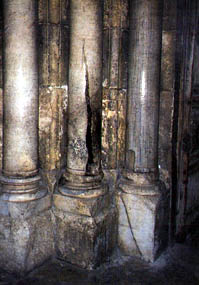
A Moslem Muezin, called Tounom, who saw the miraculous event from an adjacent mosque, abandoned immediately the Moslem religion and became an Orthodox Christian. This event took place in 1579 under Sultan Mourad IV, when the Patriarch of Jerusalem was Sophrony IV. (The mentioned split column still exists. It goes back to the XII c. The Orthodox pilgrims embrace it at the "place of the split" as the enter the church).[2, date and name are corrected]
Turkish warriors stood on the wall of a building close to the gate and lightning-struck column . When he saw this striking miracle he cried that Christ is truly God and /leaped down from a height of about ten meters. But he was not killed--stones under him get as soft as wax and his foot was imprinted in the stones. The Turks tried scrape away these prints but they could not destroy them; they were like witnesses [5].
He was burned by the Turks near the Church. His remains, gathered by the Greeks, had laid in the monastery of Panagia till XIX shedding chrism. ? I do not understand this!
Muslims who deny the Passions, Crucifixion and Resurrection of Christ tried to put obstacles in the way of the miracle. Well known Muslim (!) historian Al Biruni wrote: "… a (note: Muslim) governor brought a copper wire instead of a wick (note: of self lighting oil-lamps), in order that it won't ignite and the whole thing would fail to occur. But as the fire descended, the copper burned."[6]
It was not the only attempt. The report written by the English chronicler, Gautier Vinisauf, describes what happened in the year 1192.
"In 1187, the Saracens under the direction of Sultan Salah ad-Din took Jerusalem. In that year, the Sultan desired to be present at the celebration, even though he was not a Christian. Gautier Vinisauf tells us what happened: "On his arrival, the celestial fire descended suddenly, and the assistants were deeply moved...the Saracens... said that the fire which they had seen to come down was produced by fraudulent means. Salah ad-Din, wishing to expose the imposter, caused the lamp, which the fire from Heaven had lighted, to be extinguished, but the lamp relit immediately. He caused it to be extinguished a second time and a third time, but it relit as of itself. Thereupon, the Sultan, confounded, cried out in prophetic transport: 'Yes, soon shall I die, or I shall lose Jerusalem.'"[7]
Pictures and video / I. Miracle pictures of Holy Fire (Holy Light) in Jerusalem
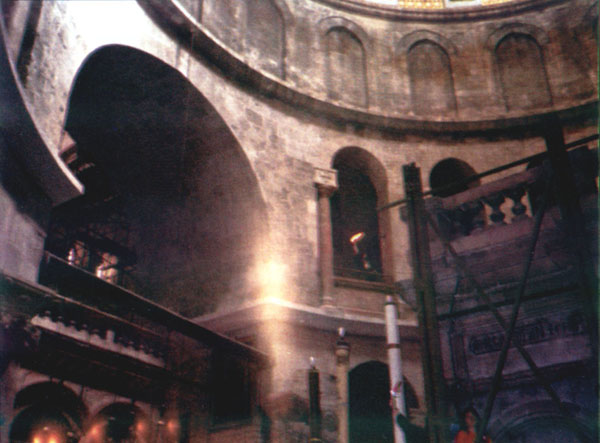
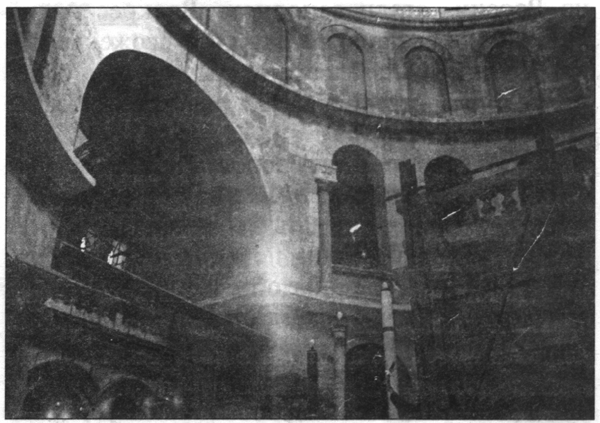
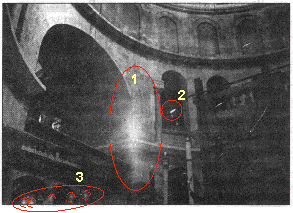
1) In the middle light pillar may be seen, fixed in a moment of the Holy Fire appearance.
2) Candles "itself" have lighten up in an arch in a hand of Armenian clergy.
3) Line of Holy Fire lights may be seen at bottom left. These is not oil-lamps - non-burning oil-lamps may be seen between lights.
Scanned from: © Gubanov Vladimir. Holy Fire: miracles on Holy Sepulchre. Moscow, "Lestvica", ed. 4, 2000, p. 280. Photo made by Blinkov Victor, inking - by author of the site.


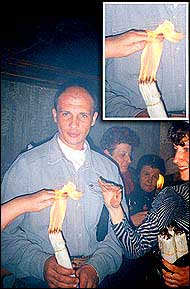
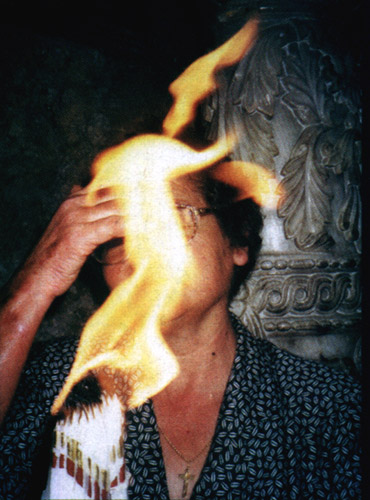
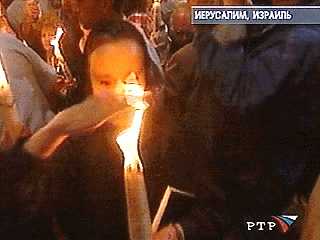
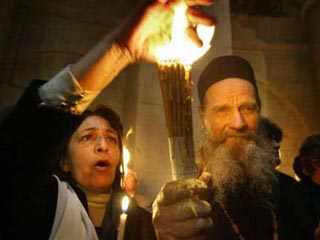
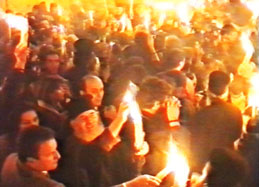
 Luminous haloes See that form of haloes on marvel picture differs: most part of them does not connected with candles or other sources of light. Taken from: Miraclous of Orthodoxy
Luminous haloes See that form of haloes on marvel picture differs: most part of them does not connected with candles or other sources of light. Taken from: Miraclous of Orthodoxy
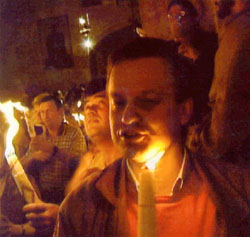
TOPICS: Current Events; Orthodox Christian; Worship
KEYWORDS: catholiclist; holyfire; pascha
Navigation: use the links below to view more comments.
first previous 1-20 ... 41-60, 61-80, 81-100, 101 last
To: Destro
I'll take my chances.
101
posted on
04/19/2004 6:27:50 PM PDT
by
monkfan
Navigation: use the links below to view more comments.
first previous 1-20 ... 41-60, 61-80, 81-100, 101 last
Disclaimer:
Opinions posted on Free Republic are those of the individual
posters and do not necessarily represent the opinion of Free Republic or its
management. All materials posted herein are protected by copyright law and the
exemption for fair use of copyrighted works.
FreeRepublic.com is powered by software copyright 2000-2008 John Robinson
 Christian worshipers surround what is traditionally believed to be the tomb of Jesus Christ, during the Holy Fire ceremony during Easter celebrations at the Church of the Holy Sepulchre in Jerusalem's Old City, Saturday, April 10, 2004. The ceremony is meant to assure the worshippers that Jesus has not forgotten them and is sending a message of hope through the fire. (AP Photo/Brennan Linsley)
Christian worshipers surround what is traditionally believed to be the tomb of Jesus Christ, during the Holy Fire ceremony during Easter celebrations at the Church of the Holy Sepulchre in Jerusalem's Old City, Saturday, April 10, 2004. The ceremony is meant to assure the worshippers that Jesus has not forgotten them and is sending a message of hope through the fire. (AP Photo/Brennan Linsley)  Israeli police in blue uniforms push back pilgrims and Evzones, right, members of the Greek Presidential guard, who escorted Greek Orthodox Patriarch of Jerusalem Irineos I, unseen background right, as he exits the tomb, during scuffles in the Holy Fire ceremony at the Church of the Holy Sepulcher in east Jerusalem's Old City Saturday, April 10, 2004. Thousands of Christian Orthodox pilgrims wait outside the tomb, where Jesus Christ is traditionally believed to be buried, for hours until the Greek Orthodox Patriarch opens the doors carrying the holy flame which is then used to light all the other candles of the faithfull. (AP Photo/Lefteris Pitarakis)
Israeli police in blue uniforms push back pilgrims and Evzones, right, members of the Greek Presidential guard, who escorted Greek Orthodox Patriarch of Jerusalem Irineos I, unseen background right, as he exits the tomb, during scuffles in the Holy Fire ceremony at the Church of the Holy Sepulcher in east Jerusalem's Old City Saturday, April 10, 2004. Thousands of Christian Orthodox pilgrims wait outside the tomb, where Jesus Christ is traditionally believed to be buried, for hours until the Greek Orthodox Patriarch opens the doors carrying the holy flame which is then used to light all the other candles of the faithfull. (AP Photo/Lefteris Pitarakis)  A Greek Orthodox monk, lights the candles of the tomb, where Jesus Christ is traditionally believed to be buried, with Holy Fire following the Holy Fire ceremony in the Church of the Holy Sepulcher at east Jerusalem's Old City Saturday, April 10, 2004. Thousands of Christian Orthodox pilgrims wait outside the tomb for hours until the Greek Orthodox Patriarch opens the doors carrying the holy flame which is then used to light all the other candles of the faithfull. (AP Photo/Lefteris Pitarakis)
A Greek Orthodox monk, lights the candles of the tomb, where Jesus Christ is traditionally believed to be buried, with Holy Fire following the Holy Fire ceremony in the Church of the Holy Sepulcher at east Jerusalem's Old City Saturday, April 10, 2004. Thousands of Christian Orthodox pilgrims wait outside the tomb for hours until the Greek Orthodox Patriarch opens the doors carrying the holy flame which is then used to light all the other candles of the faithfull. (AP Photo/Lefteris Pitarakis)  A Russian Orthodox monk, lifts up candles with Holy Fire as crowds of orthodox Christian worshippers and clergymen light candles with Holy Fire from each other during a ceremony in the Church of the Holy Sepulcher in east Jerusalem's Old City Saturday, April 10, 2004. Thousands of Christian Orthodox pilgrims wait outside the tomb, where Jesus Christ is traditionally believed to be buried, for hours until the Greek Orthodox Patriarch opens the doors carrying the holy flame which is then used to light all the other candles of the faithfull. (AP Photo/Lefteris Pitarakis)
A Russian Orthodox monk, lifts up candles with Holy Fire as crowds of orthodox Christian worshippers and clergymen light candles with Holy Fire from each other during a ceremony in the Church of the Holy Sepulcher in east Jerusalem's Old City Saturday, April 10, 2004. Thousands of Christian Orthodox pilgrims wait outside the tomb, where Jesus Christ is traditionally believed to be buried, for hours until the Greek Orthodox Patriarch opens the doors carrying the holy flame which is then used to light all the other candles of the faithfull. (AP Photo/Lefteris Pitarakis)  The lights of a candlelight procession leave trails as Christian worshippers surround what is traditionally believed to be the tomb of Jesus Christ, during the Holy Fire ceremony during Easter celebrations at the Church of the Holy Sepulchre in Jerusalem's Old City, Saturday, April 10, 2004. (AP Photo/Brennan Linsley)
The lights of a candlelight procession leave trails as Christian worshippers surround what is traditionally believed to be the tomb of Jesus Christ, during the Holy Fire ceremony during Easter celebrations at the Church of the Holy Sepulchre in Jerusalem's Old City, Saturday, April 10, 2004. (AP Photo/Brennan Linsley)  Christian worshippers hold candles at the Holy Fire ceremony during Easter celebrations at the Church of the Holy Sepulchre in Jerusalem's Old City, Saturday, April 10, 2004. The ceremony is meant to assure the worshippers that Jesus has not forgotten them and is sending a message of hope through the fire. (AP Photo/Oded Balilty)
Christian worshippers hold candles at the Holy Fire ceremony during Easter celebrations at the Church of the Holy Sepulchre in Jerusalem's Old City, Saturday, April 10, 2004. The ceremony is meant to assure the worshippers that Jesus has not forgotten them and is sending a message of hope through the fire. (AP Photo/Oded Balilty)  A Christian worshipper holds a candle at the Holy Fire ceremony during Easter celebrations at the Church of the Holy Sepulchre in Jerusalem's Old City, Saturday, April 10, 2004. The ceremony is meant to assure the worshippers that Jesus has not forgotten them and is sending a message of hope through the fire. (AP Photo/Oded Balilty)
A Christian worshipper holds a candle at the Holy Fire ceremony during Easter celebrations at the Church of the Holy Sepulchre in Jerusalem's Old City, Saturday, April 10, 2004. The ceremony is meant to assure the worshippers that Jesus has not forgotten them and is sending a message of hope through the fire. (AP Photo/Oded Balilty)  Christian worshippers and clergymen light candles outside what is traditionally believed to be the tomb of Jesus Christ during the Holy Fire ceremony during Easter celebrations at the Church of the Holy Sepulchre in Jerusalem's Old City, Saturday, April 10, 2004. The ceremony is meant to assure the worshippers that Jesus has not forgotten them and is sending a message of hope through the fire. (AP Photo/Kevin Frayer)
Christian worshippers and clergymen light candles outside what is traditionally believed to be the tomb of Jesus Christ during the Holy Fire ceremony during Easter celebrations at the Church of the Holy Sepulchre in Jerusalem's Old City, Saturday, April 10, 2004. The ceremony is meant to assure the worshippers that Jesus has not forgotten them and is sending a message of hope through the fire. (AP Photo/Kevin Frayer)  Orthodox Christians light candles inside the Church of the Holy Sepulchre during the 'Ceremony of the Holy Fire' in Jerusalem, April 10, 2004. Christian faithfuls believe the church is built on the site of Jesus' last resting place after his body was removed from the cross. The fire is first taken from inside the tomb and then rapidly spreads throughout the ancient church as faithful slight each other's candles. REUTERS/Reinhard Krause
Orthodox Christians light candles inside the Church of the Holy Sepulchre during the 'Ceremony of the Holy Fire' in Jerusalem, April 10, 2004. Christian faithfuls believe the church is built on the site of Jesus' last resting place after his body was removed from the cross. The fire is first taken from inside the tomb and then rapidly spreads throughout the ancient church as faithful slight each other's candles. REUTERS/Reinhard Krause  A Christian worshipper holds candles at the Holy Fire ceremony during Easter celebrations at the Church of the Holy Sepulchre in Jerusalem's Old City, Saturday, April 10, 2004. The ceremony is meant to assure the worshippers that Jesus has not forgotten them and is sending a message of hope through the fire. (AP Photo/Oded Balilty)
A Christian worshipper holds candles at the Holy Fire ceremony during Easter celebrations at the Church of the Holy Sepulchre in Jerusalem's Old City, Saturday, April 10, 2004. The ceremony is meant to assure the worshippers that Jesus has not forgotten them and is sending a message of hope through the fire. (AP Photo/Oded Balilty)  Christian worshippers hold candles as they walk around the Edicule, the place that is traditionally believed to be the tomb of Jesus Christ during the Holy Fire ceremony during Easter celebrations at the Church of the Holy Sepulchre in Jerusalem's Old City, Saturday, April 10, 2004. The ceremony is meant to assure the worshippers that Jesus has not forgotten them and is sending a message of hope through the fire. (AP Photo/Kevin Frayer)
Christian worshippers hold candles as they walk around the Edicule, the place that is traditionally believed to be the tomb of Jesus Christ during the Holy Fire ceremony during Easter celebrations at the Church of the Holy Sepulchre in Jerusalem's Old City, Saturday, April 10, 2004. The ceremony is meant to assure the worshippers that Jesus has not forgotten them and is sending a message of hope through the fire. (AP Photo/Kevin Frayer)  Christian worshipers hold candles during the Holy Fire ceremony during Easter celebrations at the Church of the Holy Sepulchre in Jerusalem's Old City, Saturday, April 10, 2004. The ceremony is meant to assure the worshippers that Jesus has not forgotten them and is sending a message of hope through the fire. (AP Photo/Oded Balilty)
Christian worshipers hold candles during the Holy Fire ceremony during Easter celebrations at the Church of the Holy Sepulchre in Jerusalem's Old City, Saturday, April 10, 2004. The ceremony is meant to assure the worshippers that Jesus has not forgotten them and is sending a message of hope through the fire. (AP Photo/Oded Balilty)  Christian worshipers hold candles during the Holy Fire ceremony during Easter celebrations at the Church of the Holy Sepulchre in Jerusalem's Old City, Saturday, April 10, 2004. The ceremony is meant to assure the worshippers that Jesus has not forgotten them and is sending a message of hope through the fire. (AP Photo/Oded Balilty)
Christian worshipers hold candles during the Holy Fire ceremony during Easter celebrations at the Church of the Holy Sepulchre in Jerusalem's Old City, Saturday, April 10, 2004. The ceremony is meant to assure the worshippers that Jesus has not forgotten them and is sending a message of hope through the fire. (AP Photo/Oded Balilty)  Orthodox Christians light candles inside the Church of the Holy Sepulchre as they celebrate the 'Ceremony of the Holy Fire,' in Jerusalem April 10, 2004. Christian faithful believe the church is built on the site of Jesus' last resting place after his body was removed from the cross. The fire is first taken from inside the tomb and then rapidly spreads throughout the ancient church as the faithful light each other's candles. REUTERS/Goran Tomasevic
Orthodox Christians light candles inside the Church of the Holy Sepulchre as they celebrate the 'Ceremony of the Holy Fire,' in Jerusalem April 10, 2004. Christian faithful believe the church is built on the site of Jesus' last resting place after his body was removed from the cross. The fire is first taken from inside the tomb and then rapidly spreads throughout the ancient church as the faithful light each other's candles. REUTERS/Goran Tomasevic  An Orthodox Christian man lights candles as he pray inside the Church of the Holy Sepulchre as the 'Ceremony of the Holy Fire' is celebrated, April 10, 2004. Christian faithful believe the church is built on the site of Jesus' last resting place after his body was removed from the cross. The fire is first taken from inside the tomb and then rapidly spreads throughout the ancient church as the faithful light each other's candles. REUTERS/Goran Tomasevic
An Orthodox Christian man lights candles as he pray inside the Church of the Holy Sepulchre as the 'Ceremony of the Holy Fire' is celebrated, April 10, 2004. Christian faithful believe the church is built on the site of Jesus' last resting place after his body was removed from the cross. The fire is first taken from inside the tomb and then rapidly spreads throughout the ancient church as the faithful light each other's candles. REUTERS/Goran Tomasevic  Orthodox Christians light candles as they pray inside the Church of the Holy Sepulchre during the 'Ceremony of the Holy Fire,' in Jerusalem April 10, 2004. Christian faithful believe the church is built on the site of Jesus' last resting place after his body was removed from the cross. The fire is first taken from inside the tomb and then rapidly spreads throughout the ancient church as the faithful light each other's candles. REUTERS/Goran Tomasevic
Orthodox Christians light candles as they pray inside the Church of the Holy Sepulchre during the 'Ceremony of the Holy Fire,' in Jerusalem April 10, 2004. Christian faithful believe the church is built on the site of Jesus' last resting place after his body was removed from the cross. The fire is first taken from inside the tomb and then rapidly spreads throughout the ancient church as the faithful light each other's candles. REUTERS/Goran Tomasevic  Orthodox Christians light candles inside the Church of the Holy Sepulchre as the they celebrate the 'Ceremony of the Holy Fire' in Jerusalem, April 10, 2004. Christian devotees believe the church was built on the site of Jesus' last resting place after his body was removed from the cross. The fire is first taken from inside the tomb and then rapidly spreads throughout the ancient church as the faithful light each other's candles. REUTERS/Reinhard Krause
Orthodox Christians light candles inside the Church of the Holy Sepulchre as the they celebrate the 'Ceremony of the Holy Fire' in Jerusalem, April 10, 2004. Christian devotees believe the church was built on the site of Jesus' last resting place after his body was removed from the cross. The fire is first taken from inside the tomb and then rapidly spreads throughout the ancient church as the faithful light each other's candles. REUTERS/Reinhard Krause 










 Luminous haloes See that form of haloes on marvel picture differs: most part of them does not connected with candles or other sources of light. Taken from: Miraclous of Orthodoxy
Luminous haloes See that form of haloes on marvel picture differs: most part of them does not connected with candles or other sources of light. Taken from: Miraclous of Orthodoxy 